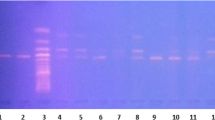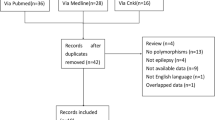Abstract
Drug-resistant epilepsy is also referred to as intractable, medically refractory, or pharmacoresistant epilepsy. Approximately, one-third of patients with epilepsy have recurrent seizures despite therapy. Multidrug resistance 1 (MDR1) gene may play a role in drug-resistance in epilepsy. To assess the association between MDR1 C3435T polymorphism and the response to anticonvulsants in childhood intractable epilepsy, we conducted a systematic review and meta-analysis. Studies were obtained from the electronic database of PubMed, Medline, Embase and CNKI up to September 2013. All the case–control association researches evaluating the role of MDR1 C3435T polymorphism in childhood epilepsy to antiepileptic drugs were identified. The odds ratios (ORs) with 95 % confidence intervals (CIs) were calculated for comparisons of the alleles and genotypes with co-dominant (C/C vs. T/T, C/T vs. T/T), dominant (C/C + C/T vs. T/T), and recessive (C/C vs. C/T + T/T) models in overall and in ethnicity subgroups to measure the strength of genetic association. A total of 8 related studies, including 634 drug-resistant patients, 615 drug-responsive patients and 1,052 healthy controls were pooled in this meta-analysis. The allelic association of MDR1 C3435T with risk of drug-resistance was not significant (OR 1.03, 95 % CI 0.87–1.22, P = 0.73; OR 1.00, 95 % CI 0.86–1.16, P = 0.98) in overall and in the subgroup analysis by ethnicity (Asian: OR 0.95, 95 % CI 0.77–1.18, P = 0.67; Caucasian: OR 1.18, 95 % CI 0.89–1.57, P = 0.25). Neither association was found in other genetic models. Our results did not show a significant association between MDR1 C3435T polymorphism and response to anticonvulsant drugs, suggesting that this polymorphism may not be a risk factor to childhood intractable epilepsy.





Similar content being viewed by others
References
Alonso-Cerezo C et al (2011) Family history of epilepsy resistant to treatment. Rev Neurol 52(9):522–526
Alpman A et al (2010) Multidrug resistance 1 (MDR1) gene polymorphisms in childhood drug-resistant epilepsy. J Child Neurol 25(12):1485–1490
Berg AT et al (2001) Early development of intractable epilepsy in children: a prospective study. Neurology 56(11):1445–1452
Bournissen FG et al (2009) Polymorphism of the MDR1/ABCB1 C3435T drug-transporter and resistance to anticonvulsant drugs: a meta-analysis. Epilepsia 50(4):898–903
Chen L et al (2007) Association of a polymorphism in MDR1 C3435T with response to antiepileptic drug treatment in ethic Han Chinese children with epilepsy. Zhongguo Dang Dai Er Ke Za Zhi 9(1):11–14
DerSimonian R, Laird N (1986) Meta-analysis in clinical trials. Control Clin Trials 7(3):177–188
Dong L et al (2011) Lack of association between ABCB1 gene polymorphisms and pharmacoresistant epilepsy: an analysis in a western Chinese pediatric population. Brain Res 1391:114–124
Emich-Widera E et al (2013) CYP3A5 *3 and C3435T MDR1 polymorphisms in prognostication of drug-resistant epilepsy in children and adolescents. Biomed Res Int 2013:526837
Gao X et al (2009) Polymorphism of multidrug-resistance gene in childhood refractory epilepsy. J Clin Pediatr 27(11):1014–1018
Geerts A et al (2010) Course and outcome of childhood epilepsy: a 15-year follow-up of the Dutch Study of Epilepsy in Childhood. Epilepsia 51(7):1189–1197
Haerian BS et al (2010) ABCB1 C3435T polymorphism and the risk of resistance to antiepileptic drugs in epilepsy: a systematic review and meta-analysis. Seizure 19(6):339–346
Haerian BS et al (2011) Association of ABCB1 gene polymorphisms and their haplotypes with response to antiepileptic drugs: a systematic review and meta-analysis. Pharmacogenomics 12(5):713–725
Ishikawa T et al (2004) Functional evaluation of ABCB1 (P-glycoprotein) polymorphisms: high-speed screening and structure-activity relationship analyses. Drug Metab Pharmacokinet 19(1):1–14
Johnson MR et al (2003) A twin study of genetic influences on epilepsy outcome. Twin Res 6(2):140–146
Juliano RL, Ling V (1976) A surface glycoprotein modulating drug permeability in Chinese hamster ovary cell mutants. Biochim Biophys Acta 455(1):152–162
Kim DW et al (2006) Lack of association between C3435T nucleotide MDR1 genetic polymorphism and multidrug-resistant epilepsy. Seizure 15(5):344–347
Komar AA (2007) Silent SNPs: impact on gene function and phenotype. Pharmacogenomics 8(8):1075–1080
Kwan P, Brodie MJ (2005) Potential role of drug transporters in the pathogenesis of medically intractable epilepsy. Epilepsia 46(2):224–235
Kwan P et al (2010) Definition of drug resistant epilepsy: consensus proposal by the ad hoc task force of the ILAE commission on therapeutic strategies. Epilepsia 51(6):1069–1077
Kwan P, Schachter SC, Brodie MJ (2011) Drug-resistant epilepsy. N Engl J Med 365(10):919–926
Lazarowski A, Czornyj L (2011) Potential role of multidrug resistant proteins in refractory epilepsy and antiepileptic drugs interactions. Drug Metabol Drug Interact 26(1):21–26
Leschziner G et al (2006a) Exon sequencing and high resolution haplotype analysis of ABC transporter genes implicated in drug resistance. Pharmacogenet Genomics 16(6):439–450
Leschziner G et al (2006b) Clinical factors and ABCB1 polymorphisms in prediction of antiepileptic drug response: a prospective cohort study. Lancet Neurol 5(8):668–676
Leschziner GD et al (2007) Common ABCB1 polymorphisms are not associated with multidrug resistance in epilepsy using a gene-wide tagging approach. Pharmacogenet Genomics 17(3):217–220
Loscher W, Potschka H (2005) Blood-brain barrier active efflux transporters: ATP-binding cassette gene family. NeuroRx 2(1):86–98
Loscher W et al (2009) The clinical impact of pharmacogenetics on the treatment of epilepsy. Epilepsia 50(1):1–23
Mantel N, Haenszel W (1959) Statistical aspects of the analysis of data from retrospective studies of disease. J Natl Cancer Inst 22(4):719–748
Oka E et al (2006) Prevalence of childhood epilepsy and distribution of epileptic syndromes: a population-based survey in Okayama, Japan. Epilepsia 47(3):626–630
Pharmacoresistance in epilepsy (2013) Proceedings of the 2nd Halifax International epilepsy conference and retreat. September 21–22, 2012. Halifax, Nova Scotia, Canada. Epilepsia 54(Suppl 2):1–85
Salanti G et al (2005) Hardy–Weinberg equilibrium in genetic association studies: an empirical evaluation of reporting, deviations, and power. Eur J Hum Genet 13(7):840–848
Saygi S et al (2013) Multidrug resistance 1 (MDR1) 3435C/T genotyping in childhood drug-resistant epilepsy. Brain Dev 36(2):137–142
Schinkel AH et al (1994) Disruption of the mouse mdr1a P-glycoprotein gene leads to a deficiency in the blood-brain barrier and to increased sensitivity to drugs. Cell 77(4):491–502
Schmidt D, Loscher W (2005) Drug resistance in epilepsy: putative neurobiologic and clinical mechanisms. Epilepsia 46(6):858–877
Shorvon S (2007) The treatment of chronic epilepsy: a review of recent studies of clinical efficacy and side effects. Curr Opin Neurol 20(2):159–163
Siddiqui A et al (2003) Association of multidrug resistance in epilepsy with a polymorphism in the drug-transporter gene ABCB1. N Engl J Med 348(15):1442–1448
Sillanpaa M, Schmidt D (2006) Natural history of treated childhood-onset epilepsy: prospective, long-term population-based study. Brain 129(Pt 3):617–624
Speed D et al (2013) A genome-wide association study and biological pathway analysis of epilepsy prognosis in a prospective cohort of newly treated epilepsy. Hum Mol Genet 23(1): 247–258
Tan NC et al (2004) Failure to confirm association of a polymorphism in ABCB1 with multidrug-resistant epilepsy. Neurology 63(6):1090–1092
von Stulpnagel C et al (2009) Letter: lack of association between MDR1 polymorphisms and pharmacoresistance to anticonvulsive drugs in patients with childhood-onset epilepsy. Epilepsia 50(7):1835–1837
Waaler PE et al (2000) Prevalence, classification, and severity of epilepsy in children in western Norway. Epilepsia 41(7):802–810
Wang SY, Gao F, Xia ZZ (2008) Association of a polymorphism in MDR1C3435T with intractable epilepsy of children. Zhejiang Med J 30(12):1307–1309, 1312
Woolf B (1955) On estimating the relation between blood group and disease. Ann Hum Genet 19(4):251–253
Zamponi N et al (2008) Vagus nerve stimulation (VNS) is effective in treating catastrophic 1 epilepsy in very young children. Neurosurg Rev 31(3):291–297
Zimprich F et al (2004) Association of an ABCB1 gene haplotype with pharmacoresistance in temporal lobe epilepsy. Neurology 63(6):1087–1089
Author information
Authors and Affiliations
Corresponding author
Rights and permissions
About this article
Cite this article
Sun, G., Sun, X. & Guan, L. Association of MDR1 gene C3435T polymorphism with childhood intractable epilepsy: a meta-analysis. J Neural Transm 121, 717–724 (2014). https://doi.org/10.1007/s00702-014-1169-3
Received:
Accepted:
Published:
Issue Date:
DOI: https://doi.org/10.1007/s00702-014-1169-3




